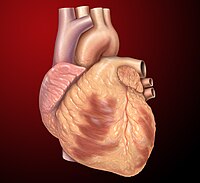
Photo from wikipedia
July 14, 2020 e27 Franz H. Messerli, MD George C.M. Siontis , MD, PhD Lorenz Räber, MD, PhD To the Editor: We read with interest the provocative article by Raphael… Click to show full abstract
July 14, 2020 e27 Franz H. Messerli, MD George C.M. Siontis , MD, PhD Lorenz Räber, MD, PhD To the Editor: We read with interest the provocative article by Raphael et al.1 The authors conclude, “The incidence of T2MI is similar to that of T1MI in contemporary years.” Of note, in both types of myocardial infarction, the incidence of hypertension also was similar, amounting to 68% and 71%, respectively. For type 1 myocardial infarction (T1MI), such a high incidence is not unexpected, because hypertension is known to be a powerful risk factor for coronary artery disease. In contrast, for type 2 myocardial infarction (T2MI), “a diagnosis of hypertension was found to be associated with lower all-cause mortality,”1 despite the fact that long-term mortality after T2MI was higher than after T1MI. Thus, hypertension paradoxically had a protective effect; its presence was an indicator of better prognosis in patients with T2MI. The relationship between blood pressure (BP) and T2MI is more complex than the one between BP and T1MI. For T1MI, hypertension is simply a risk factor, with its duration and severity having a cumulative effect on the occurrence of an event. In contrast, for T2MI, only excessively high or excessively low BP levels consist a definitive risk; mild hypertension is prone to mitigate the risk of hypotension and therefore, as seen in the present study, may exert a protective effect. The complexity of the relationship between BP and T1MI and T2MI may well be the culprit of the somewhat archaic thought 4 decades ago that “in severe middle-aged hypertensives, attempts at ‘normalization’ of high blood-pressure may precipitate as many infarctions as it prevents” and that therefore “the BP in such patients should seldom be reduced...to diastolic levels <104 to 110 mm Hg.”2 Excessive hypotension associated with inappropriate antihypertensive therapy may well give rise to T2MI,3 particularly in older patients. In contrast to T1MI, T2MI can be triggered by hypotension or uncontrolled hypertension as well as by excessive BP variability.4 We wonder whether the authors’ unique database would allow them to better elucidate the relationship between BP and T2MI. Does the protective effect of hypertension in T2MI depend on the underlying cause? What was the incidence of hypotension, and what was defined as malignant hypertension as a triggering event in the authors’ T2MI population?
Journal Title: Circulation
Year Published: 2020
Link to full text (if available)
Share on Social Media: Sign Up to like & get
recommendations!